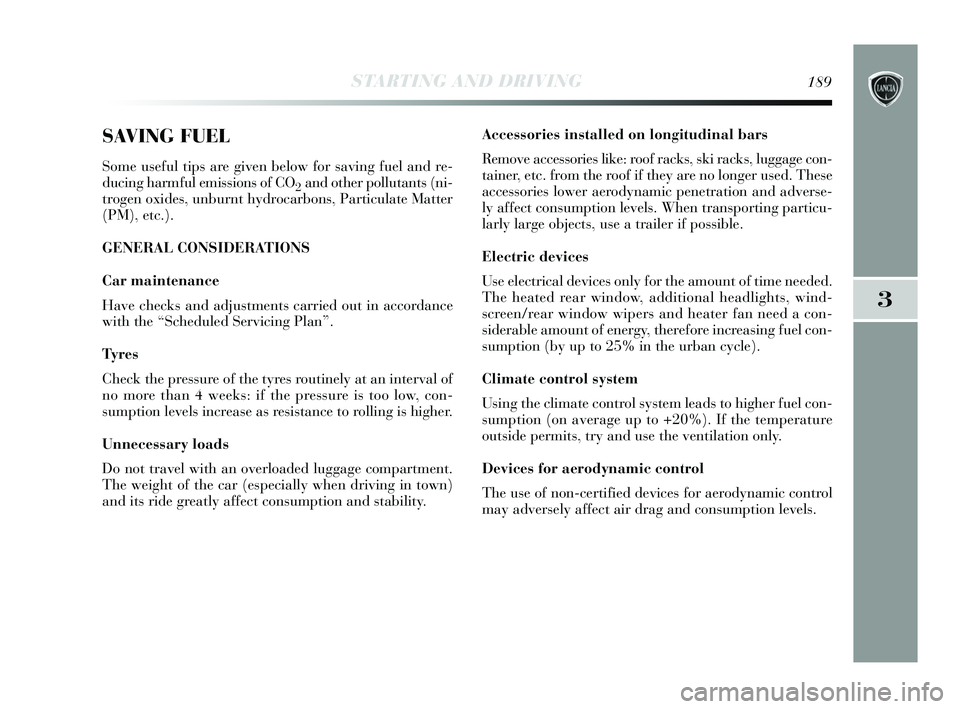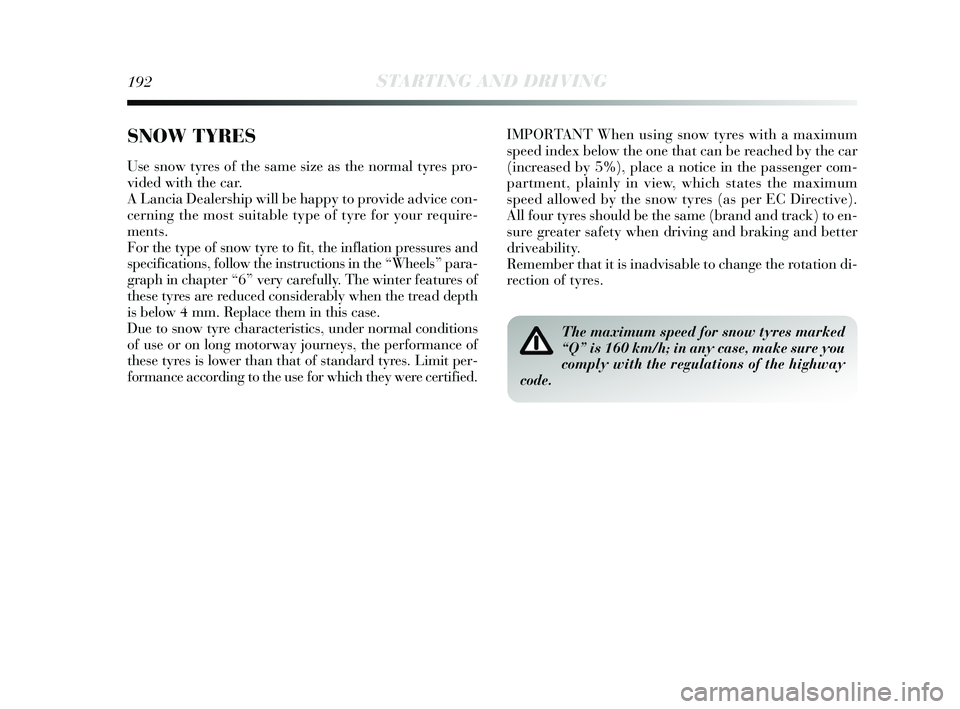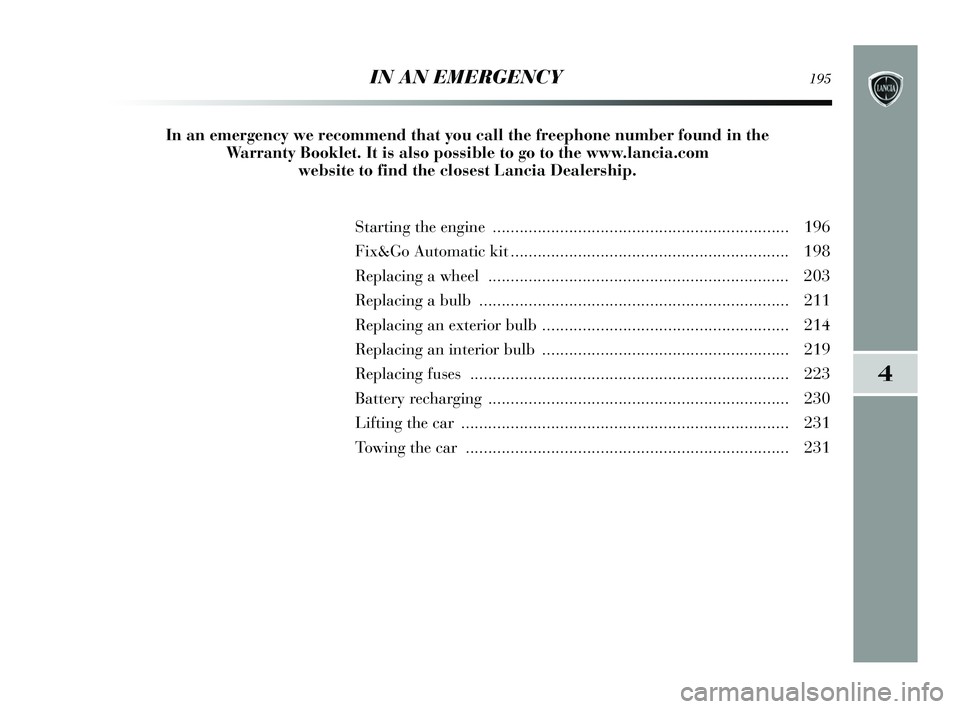Lancia Delta 2015 Owner handbook (in English)
Manufacturer: LANCIA, Model Year: 2015, Model line: Delta, Model: Lancia Delta 2015Pages: 291, PDF Size: 6.74 MB
Page 191 of 291

STARTING AND DRIVING189
3
SAVING FUEL
Some useful tips are given below for saving fuel and re-
ducing harmful emissions of CO
2and other pollutants (ni-
trogen oxides, unburnt hydrocarbons, Particulate Matter
(PM), etc.).
GENERAL CONSIDERATIONS
Car maintenance
Have checks and adjustments carried out in accordance
with the “Scheduled Servicing Plan”.
Ty r e s
Check the pressure of the tyres routinely at an interval of
no more than 4 weeks: if the pressure is too low, con-
sumption levels increase as resistance to rolling is higher.
Unnecessary loads
Do not travel with an overloaded luggage compartment.
The weight of the car (especially when driving in town)
and its ride greatly affect consumption and stability. Accessories installed on longitudinal bars
Remove accessories like: roof racks, ski racks, luggage con-
tainer, etc. from the roof if they are no longer used. These
accessories lower aerodynamic penetration and adverse-
ly affect consumption levels. When transporting particu-
larly large objects, use a trailer if possible.
Electric devices
Use electrical devices only for the amount of time needed.
The heated rear window, additional headlights, wind-
screen/rear window wipers and heater fan need a con-
siderable amount of energy, therefore increasing fuel con-
sumption (by up to 25% in the urban cycle).
Climate control system
Using the climate control system leads to higher fuel con-
sumption (on average up to +20%). If the temperature
outside permits, try and use the ventilation only.
Devices for aerodynamic control
The use of non-certified devices for aerodynamic control
may adversely affect air drag and consumption levels.
183-194 Delta GB 1ed 26/08/13 12.15 Pagina 189
Page 192 of 291

190STARTING AND DRIVING
DRIVING STYLE
Cranking
Do not warm up the engine at low or high revs when the
car is stationary: under these conditions the engine warms
up much more slowly, increasing consumption and emis-
sions. It is therefore advisable to move off immediately,
slowly, avoiding high speeds: in this way the engine will
warm up more quickly.
Unnecessary actions
Avoid revving up when at traffic lights or before stopping
the engine. The latter action, like double-declutching, is
completely unnecessary and causes increased fuel con-
sumption and pollution.
Gear selection
As soon as the conditions of the traffic and road permit,
use a higher gear. Using a low gear for faster accelera-
tion will increase consumption.
In the same way improper use of a high gear increases con-
sumption, emissions and engine wear.
Max. speed
Fuel consumption considerably increases as speed in-
creases. Maintain a constant speed, avoiding unnecessary
braking and acceleration, which cost in terms of both fu-
el consumption and emissions.Acceleration
Accelerating violently will greatly affect consumption and
emissions: acceleration should be gradual.
CONDITIONS OF USE
Cold starting
Short journeys and frequent cold starts do not allow the
engine to reach optimum operating temperature. This re-
sults in a significant increase in consumption levels (from
+15 to +30% on the urban cycle) and emissions.
Traffic and road conditions
Rather high fuel consumption is caused by heavy traffic,
for instance when travelling in a queue with frequent use
of low gears or in large towns with many traffic lights.
Mountain and rough roads also have a negative effect on
fuel consumption.
Stops in traffic
During prolonged stops (e.g. level crossings) the engine
should be switched off.
183-194 Delta GB 1ed 26/08/13 12.15 Pagina 190
Page 193 of 291

STARTING AND DRIVING191
3
TOWING TRAILERS
IMPORTANT
For towing caravans or trailers the car must be fitted with
a certified tow hook and an adequate electrical system. In-
stallation should be carried out by specialised personnel
who will issue the required papers for travelling on roads.
Install any specific and/or additional door mirrors as spec-
ified by the Highway Code.
Remember that when towing a trailer, steep hills are hard-
er to climb, braking spaces increase and overtaking takes
longer depending on the overall weight.
Engage a low gear when driving downhill, rather than con-
stantly using the brake.
The weight the trailer exerts on the car tow hook reduces
the car’s loading capacity by the same amount. To make
sure that the maximum towable weight is not exceeded
(given in the car registration document) account should
be taken of the fully laden trailer, including accessories
and luggage.
Do not exceed the speed limits specific to each country you
are driving in, in the case of vehicles towing trailers. In
any case, the top speed must not exceed 100 km/h.
The ABS with which the vehicle may be
equipped does not control the braking system
of the trailer. Take specific care when trav-
elling on slippery roads.
Never modify the braking system of the car
to control the trailer brake. The trailer brak-
ing system must be fully independent from
the hydraulic system of the car.
183-194 Delta GB 1ed 26/08/13 12.15 Pagina 191
Page 194 of 291

192STARTING AND DRIVING
IMPORTANT When using snow tyres with a maximum
speed index below the one that can be reached by the car
(increased by 5%), place a notice in the passenger com-
partment, plainly in view, which states the maximum
speed allowed by the snow tyres (as per EC Directive).
All four tyres should be the same (brand and track) to en-
sure greater safety when driving and braking and better
driveability.
Remember that it is inadvisable to change the rotation di-
rection of tyres.
The maximum speed for snow tyres marked
“Q” is 160 km/h; in any case, make sure you
comply with the regulations of the highway
code.
SNOW TYRES
Use snow tyres of the same size as the normal tyres pro-
vided with the car.
A Lancia Dealership will be happy to provide advice con-
cerning the most suitable type of tyre for your require-
ments.
For the type of snow tyre to fit, the inflation pressures and
specifications, follow the instructions in the “Wheels” para-
graph in chapter “6” very carefully. The winter features of
these tyres are reduced considerably when the tread depth
is below 4 mm. Replace them in this case.
Due to snow tyre characteristics, under normal conditions
of use or on long motorway journeys, the performance of
these tyres is lower than that of standard tyres. Limit per-
formance according to the use for which they were certified.
183-194 Delta GB 1ed 26/08/13 12.15 Pagina 192
Page 195 of 291

STARTING AND DRIVING193
3
Keep your speed down when snow chains are
fitted. Do not exceed 50 km/h. Avoid potholes,
steps and pavements and also avoid driving
long distances on roads not covered with snow in
order to prevent damaging the car and the roadbed.
SNOW CHAINS
The use of snow chains should be in compliance with lo-
cal regulations.
The snow chains may be applied only onto the front wheel
(drive wheels).
Check the tension of the snow chains after the first few
metres have been driven.
IMPORTANT Snow chains cannot be fitted to the space-
saver wheel. So, if a front (drive) wheel is punctured and
chains are needed, a rear wheel should be fitted to the front
of the car and the space-saver wheel should be fitted to
the rear. In this way, with two normal drive wheels at the
front, snow chains can be fitted.
CAR INACTIVITY
If the car is to be left inactive for longer than a month, the
following precautions should be followed:
❍ park the car in a covered, dry and, if possible, well-
ventilated place;
❍ engage a gear;
❍ check that the handbrake is not engaged;
❍ disconnect the negative battery terminal;
❍ clean and protect the painted parts of the vehicle with
protective wax;
❍ clean and protect the shiny metal parts using special
compounds commercially available;
❍ sprinkle talcum powder on the rubber windscreen and
rear window wiper blades and lift them off the glass;
❍ open the windows slightly;
❍ cover the car with a fabric or perforated plastic sheet.
Do not use sheets of non-perforated plastic as they do
not allow moisture on the car body to evaporate;
❍ inflate tyres to a pressure of +0.5 bar above the nor-
mal specified pressure and check regularly;
❍ do not drain the engine cooling system.
183-194 Delta GB 1ed 26/08/13 12.15 Pagina 193
Page 196 of 291

194STARTING AND DRIVING
blank page
183-194 Delta GB 1ed 26/08/13 12.15 Pagina 194
Page 197 of 291

4
IN AN EMERGENCY195
Starting the engine .................................................................. 196
Fix&Go Automatic kit.............................................................. 198
Replacing a wheel ................................................................... 203
Replacing a bulb ..................................................................... 211
Replacing an exterior bulb ....................................................... 214
Replacing an interior bulb ....................................................... 219
Replacing fuses ....................................................................... 223
Battery recharging ................................................................... 230
Lifting the car ........................................................................\
. 231
Towing the car ........................................................................\
231
In an emergency we recommend that you call the freephone number found in\
the
Warranty Booklet. It is also possible to go to the www.lancia.com website to find the closest Lancia Dealership.
195-232 Delta GB 1ed 03/03/14 09.14 Pagina 195
Page 198 of 291

196IN AN EMERGENCY
STARTING THE ENGINE
Go to a Lancia Dealership immediately if instrument pan-
el
Ywarning light remains on constantly.
JUMP STARTING fig. 1
If the battery is flat, the engine may be started using an
auxiliary battery with the same capacity or a little high-
er than the flat one.
fig. 1L0E0074m
Strictly avoid using a rapid battery charger
for jump starting: this could damage the elec-
tronic systems and the engine fuel supply and
ignition control units.
This starting procedure must be carried out
by expert personnel as incorrect manoeuvres
can cause electrical discharges of consider-
able intensity. Furthermore, battery fluid is poiso-
nous and corrosive: avoid contact with skin and
eyes. Keep naked flames away from the battery. No
smoking. Do not cause sparks.
195-232 Delta GB 1ed 03/03/14 09.14 Pagina 196
Page 199 of 291

IN AN EMERGENCY197
4
Proceed as follows to start the car:
❍connect the positive terminals (+ sign close to the ter-
minal) of both batteries using a lead;
❍ with a second lead, connect the negative terminal –
of the auxiliary battery to an earthing point E
on the
engine or the gearbox of the car to be started;
❍ start the engine;
❍ when the engine has been started, follow the sequence
above in reverse order to remove the leads.
If after a few attempts the engine does not start, do not
persist but contact a Lancia Dealership.
IMPORTANT Do not directly connect the negative ter-
minals of the two batteries: any sparks may ignite the ex-
plosive gas which could come out of the battery. If the aux-
iliary battery is installed on another car, prevent any con-
tact between metal parts of the two cars. BUMP STARTING
Never bump start the engine by pushing, towing or coast-
ing downhill.
This could cause fuel to flow into the catalytic converter
and damage it beyond repair.
IMPORTANT Remember that the brake servo and elec-
trical power steering system (where provided) are not op-
erational until the engine is started, a greater effort will
therefore be required to press the brake pedal or turn the
steering wheel.
195-232 Delta GB 1ed 03/03/14 09.14 Pagina 197
Page 200 of 291

198IN AN EMERGENCY
❍a compressor D - fig. 2 including a pressure gauge and
connectors, found in the compartment;
❍ a pair of protective gloves located in the side com-
partment of the compressor;
❍ adapters for inflating different elements.
The quick tyre repair kit also contains a screwdriver and
a tow hook.
fig. 3L0E0076m
FIX & GO AUTOMATIC KIT
The Fix & Go Automatic quick tyre repair kit is located
in the luggage compartment.
The kit fig. 2 includes:
❍ a bottle A containing sealant and fitted with:
– filler pipe B;
– an adhesive label C with the message “max. 80 km/h” to be applied in a position clearly visible by
the driver (on the dashboard) after repairing the tyre;
❍ informative leaflet (see fig. 3), used to ensure the cor-
rect use of the quick tyre repair kit and then given to
the personnel who will be handling the treated tyre;
fig. 2L0E0075m
195-232 Delta GB 1ed 03/03/14 09.14 Pagina 198